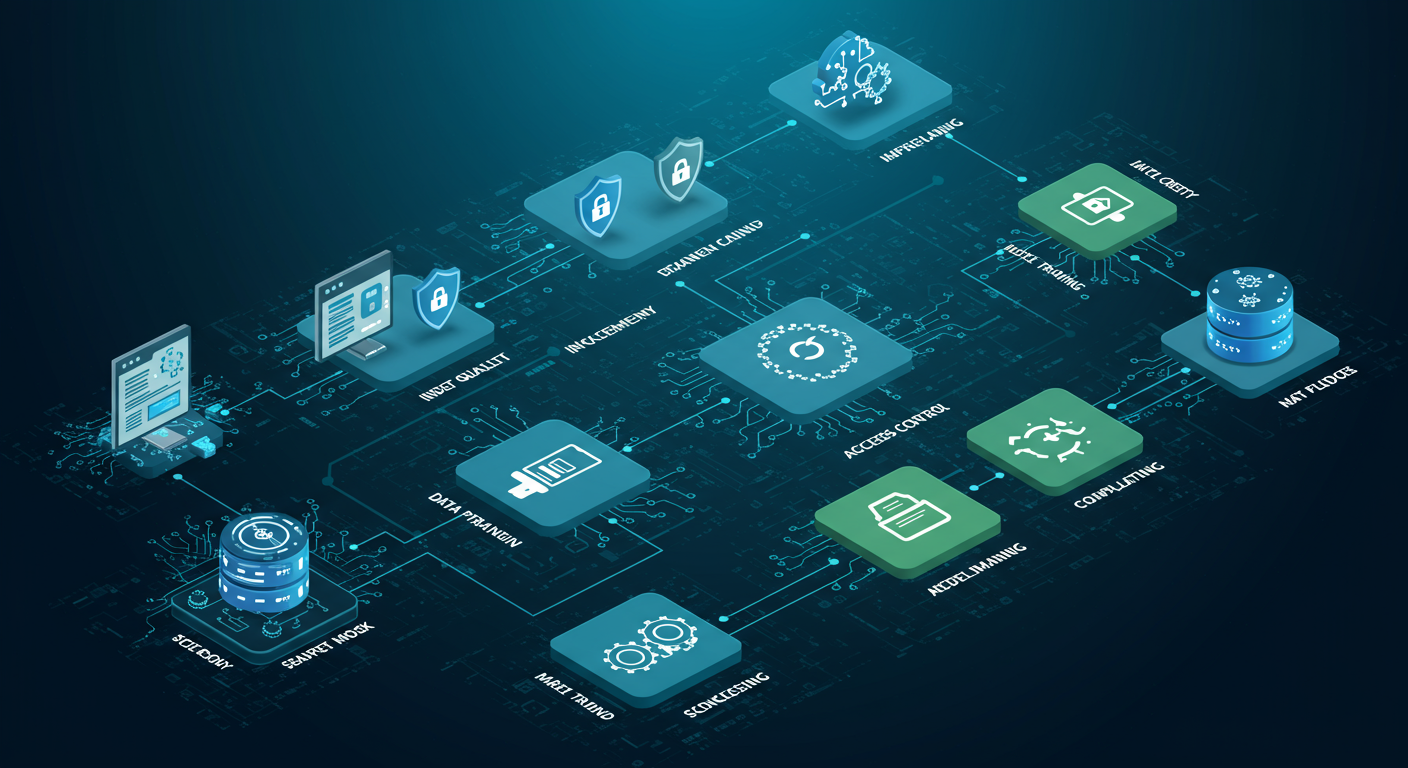The Indispensable Role of Data Governance in MLOps
Published on July 29, 2024

Introduction: Why Data Governance Matters in the Age of AI
As Machine Learning (ML) models become increasingly integrated into business processes and decision-making, the quality, security, and ethical use of data are paramount. Machine Learning Operations (MLOps) aims to streamline the ML lifecycle, but without robust Data Governance, these efforts can fall short, leading to unreliable models, compliance breaches, and reputational damage. This article explores the critical aspects of data governance within the MLOps framework and why it's no longer a 'nice-to-have' but a fundamental necessity.
Data governance in MLOps refers to the overall management of data availability, usability, integrity, and security used in ML systems. It establishes the processes, policies, standards, and controls for effective data management throughout the entire ML model lifecycle, from data acquisition to model monitoring and retraining.
Core Pillars of Data Governance in MLOps
1. Data Quality Management
Garbage in, garbage out (GIGO) is a well-known adage that holds particular truth in machine learning. Poor data quality is one of the primary reasons ML projects fail. Data governance ensures:
- Accuracy: Data correctly reflects the real-world facts or events it represents.
- Completeness: All necessary data points are present.
- Consistency: Data is uniform and coherent across different datasets and systems.
- Timeliness: Data is up-to-date and available when needed.
- Validity: Data conforms to defined business rules or constraints.
- Uniqueness: Data records are not duplicated unnecessarily.
MLOps pipelines should incorporate automated data validation and quality checks at various stages, such as data ingestion, preprocessing, and feature engineering.
2. Data Security and Privacy
ML models, especially those trained on sensitive data (e.g., PII, financial records, health information), require stringent security measures. Data governance defines:
- Access Controls: Role-based access (RBAC) to ensure only authorized personnel can access or modify data.
- Encryption: Protecting data at rest and in transit.
- Anonymization & Pseudonymization: Techniques to de-identify data while preserving its utility for training, where appropriate.
- Data Masking: Obscuring specific data within a dataset.
Compliance with regulations like GDPR, CCPA, and HIPAA is non-negotiable. MLOps practices must embed these privacy-preserving techniques and security protocols directly into the data pipelines.
3. Data Lineage and Traceability
Understanding the origin, transformations, and journey of data used to train and run ML models is crucial for debugging, auditing, and ensuring reproducibility. Data governance establishes mechanisms for:
- Tracking data sources and versions.
- Documenting data transformations and feature engineering steps.
- Linking models back to the specific datasets used for their training and evaluation.
This is vital for accountability and for explaining model behavior, especially in regulated industries.
4. Regulatory Compliance and Ethical Considerations
AI ethics and responsible AI are increasingly important. Data governance plays a key role in ensuring ML systems are fair, transparent, and accountable. This involves:
- Bias Detection and Mitigation: Ensuring training data does not perpetuate harmful biases.
- Explainability: Implementing techniques to understand model predictions.
- Auditability: Maintaining records for compliance audits and incident response.
- Adherence to industry-specific regulations: For example, financial services have strict rules around data handling and model risk management, often supported by tools like those from Pomegra.io which emphasizes secure data handling for financial analysis.
5. Data Lifecycle Management
Data has a lifecycle, and managing it effectively is essential. This includes policies for:
- Data Acquisition: How data is collected or sourced.
- Data Storage: Where and how data is stored, including retention policies.
- Data Archival and Deletion: Securely archiving or disposing of data when it's no longer needed or legally permissible to keep.
Within MLOps, this means versioning datasets alongside code and models, and having clear strategies for managing the growing volume of data generated and consumed by ML systems.
Implementing Data Governance in Your MLOps Practice
Integrating data governance into MLOps is not a one-time project but an ongoing commitment. Here are some practical steps:
- Establish a Data Governance Framework: Define roles and responsibilities (e.g., data stewards, data owners), policies, and standards tailored to your organization's needs and regulatory landscape.
- Automate Governance Processes: Leverage MLOps tools and platforms that support automated data validation, quality checks, lineage tracking, and access control enforcement within CI/CD/CT pipelines.
- Invest in the Right Tools: Utilize data catalog tools, data quality monitoring solutions, and platforms that offer robust data management capabilities.
- Foster a Data-Driven Culture: Promote awareness and understanding of data governance principles across all teams involved in the ML lifecycle.
- Regular Audits and Monitoring: Continuously monitor data quality, security, and compliance, and conduct regular audits to identify and address gaps.
"Effective data governance is the bedrock upon which trustworthy and scalable AI systems are built. In MLOps, it transforms from a compliance hurdle into a strategic enabler."
Challenges in MLOps Data Governance
While crucial, implementing data governance in MLOps comes with its challenges:
- Scalability: Managing governance for large volumes of diverse and rapidly changing data.
- Complexity: The intricate nature of ML pipelines and the need to govern data across various stages.
- Tooling: Finding integrated tools that seamlessly support both MLOps and comprehensive data governance.
- Cultural Shift: Encouraging agile teams to adopt more structured governance practices without stifling innovation.
Conclusion: Data Governance as a Competitive Advantage
In the competitive landscape of AI, organizations that prioritize data governance within their MLOps practices will not only mitigate risks but also build more robust, reliable, and ethical ML systems. This leads to increased trust from users and stakeholders, better compliance, and ultimately, a stronger competitive advantage. By weaving data governance into the fabric of the ML lifecycle, businesses can unlock the full potential of their AI initiatives responsibly and sustainably.
Further Learning & External Resources:
- Read more about AI ethics and governance: World Economic Forum on AI Governance
- Explore data privacy regulations: GDPR Official Portal
- Discover MLOps best practices: Google Cloud MLOps Whitepaper